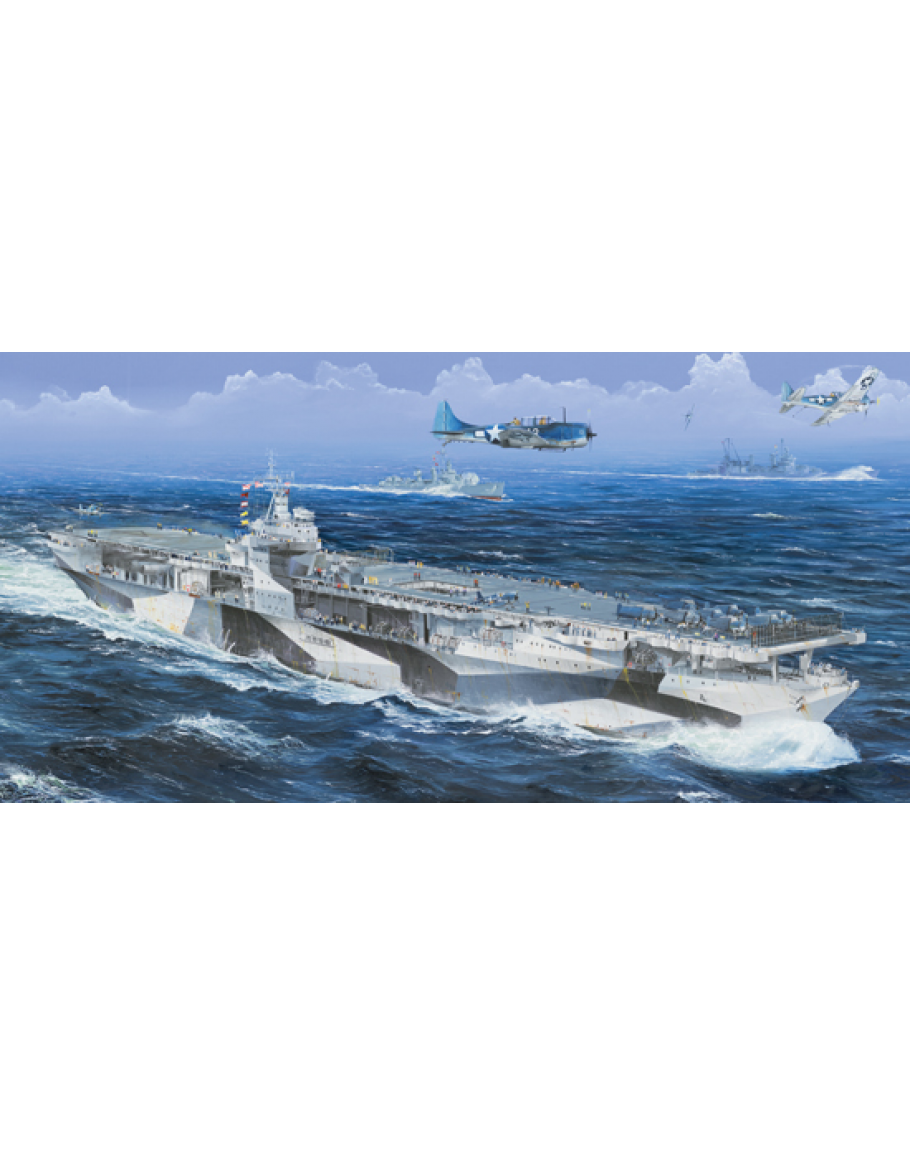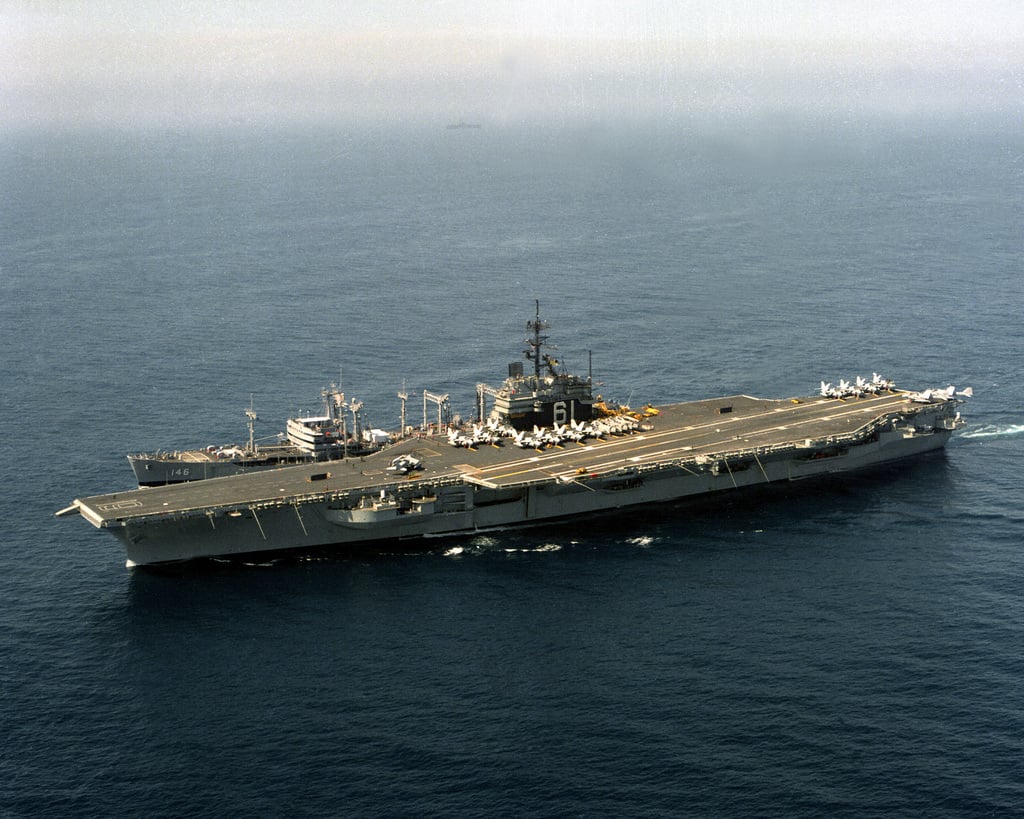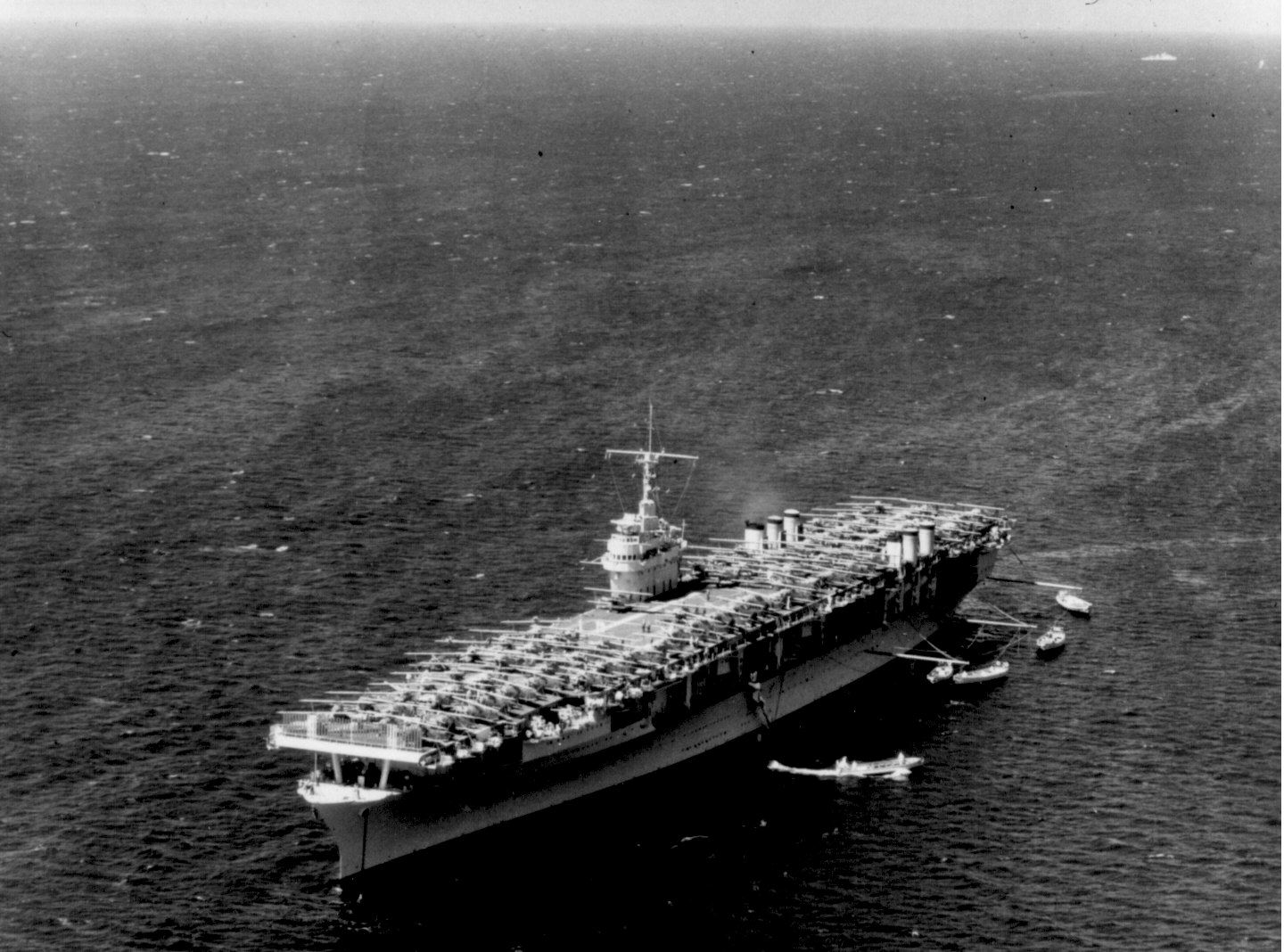Ranger Aircraft Carrier - The elder Saratoga was Lexington's sister ship, also converted into an aircraft carrier from a battlecruiser in 1922. Unlike her sister, however, she survived multiple hits from the Japanese in World War II. Her fatal encounter was with the U.S.
military, when she was sunk as part of atomic bomb testing in the Bikini Atoll in 1946. The initial "air burst" test did little damage, but a subsequent underwater bomb test did the ship in. Today she serves as an attraction for scuba divers.
Ranger Aircraft Carrier

The ship was the second U.S. light aircraft carrier, this one weighing 13,000 tons and measuring 623 feet, was commissioned in 1943. Princeton was designed to carry 45 aircraft. She fought for just over a year and a half before she was sunk at the Battle of Leyte Gulf in 1944, taking 108 men with her.
Interwar Years
USS Wright (CVL-49) was the second in the Saipan class, weighing 14,500 tons, 684 feet long, and built for about 50 aircraft. Commissioned in February 1947, she was converted to a command ship in 1963 but retained her original name.
She was decommissioned in 1970 and sold for scrap in 1980. These efforts were constrained by the limits imposed by the Washington Naval Treaty which capped both the size of individual ships and the total tonnage.
With the completion of Lexington and Saratoga, the US Navy had 69,000 tons remaining which could be assigned to aircraft carriers. As such, the US Navy intended for the new design to displace 13,800 tons per ship so that five carriers could be constructed.
Despite these intentions, only one ship of the new class would actually be built. The ship was the lead in a new class of larger carriers. When commissioned in September 1945 she weighed 45,000 tons—though she put on another 21,000 pounds before decommissioning—was 972 feet long and could theoretically carry 137 planes, though in reality the Navy learned she couldn't coordinate operations for that many.
With The Home Fleet
Most of the action she saw was in Vietnam, where she laid mines around North Vietnamese ports and later evacuated refugees as South Vietnam collapsed. She also played a part in Operation Desert Storm. She was decommissioned in 1992. Eleven years later, work began to turn the Midway into a museum.
In 2004 she opened as a museum at the Navy Pier in San Diego. Six Essex-class carriers with hull numbers CV-50 through CV-55 were ordered in 1944, but all were canceled before construction began. The Midway-class carriers CV-56 and CV-57 were also canceled before their keels had been laid.
CV-58, the lead ship in a new class—tentatively to be named the United States, was likewise canceled, but only five days after the keel was finished in 1949. Later in August, Ranger departed on an extended shakedown cruise to South America which included port calls at Rio de Janeiro, Buenos Aires, and Montevideo.

Returning to Norfolk, VA, the carrier conducted operations locally before receiving orders for the Pacific in April 1935. Passing through the Panama Canal, Ranger arrived at San Diego, CA on the 15th. USS Lake Champlain (CV-39) was commissioned in June 1945, in time to carry troops home from World War II combat theaters.
World War Ii Begins
An Essex-class carrier, she weighed 27,100 tons, measured 888 feet and could hold 90 to 100 aircraft. The ship served in Korea and helped block Cuba during the Cuban Missile Crisis. In 1969 she was decommissioned.
Three years later she was sold for scrap. Departing the yard, Ranger carried a load of P-40s to Africa for use by the 58th Fighter Group before spending much of the summer of 1943 conducting pilot training off the New England coast.
Crossing the Atlantic in late August, the carrier joined the British Home Fleet at Scapa Flow in the Orkney Islands. Putting out on October 2 as part of Operation Leader, Ranger and a combined Anglo-American force moved towards Norway with the goal of attacking German shipping around Vestfjorden.
John F. Kennedy was commissioned in 1968. It's the last conventionally powered carrier the U.S. Navy builds ahead of the Nimitz-class of nuclear carriers. The ship spent most of the 1970s in the Atlantic and the Mediterranean and responded to the Marine Barracks bombing in Beirut, Lebanon in 1983. The ship also fought during Operation Desert Storm.
Scroll Down For Footage
The ship was decommissioned in 2007. The ship is currently part of the Philadelphia reserve fleet. USS RANGER was the third ship in the FORRESTAL-class and the second carrier in the Navy to bear this name.
Commissioned as attack aircraft carrier CVA 61, the RANGER was redesignated as multi-purpose aircraft carrier CV 61 on June 30, 1975. USS RANGER was last homeported in San Diego, Calif. After decommissioning the RANGER was laid-up at the Naval Inactive Ship Maintenance Facility at Bremerton, Wash., awaiting possible future use as a museum ship.
The museum plans, however, were canceled and on December 22, 2014, the RANGER was sold for scrapping to International Shipbreaking Ltd. of Brownsville, Tx., for one cent. On March 5, 2015, the RANGER left Bremerton, Wash., under tow enroute to Brownsville, Tx., where she arrived on July 12, 2015. Scrapping at Brownsville was finished on November 1, 2017.
The ship was commissioned in November 1946. The last Essex-class carrier to join the fleet, she weighed 27,100 tons and measured 888 feet in length, with a capacity for 90 to 100 aircraft. She launched the first bombing strike of the Korean War in 1950 and deployed there repeatedly through 1952, and also performed combat deployments during the Vietnam War.

Design Development
Valley Forge was slated to become a museum after she was decommissioned in 1970, but funding fell through, and she was sold to Nicolae Joffre Corp. for scrapping instead in 1971. In the meantime, however, she was used as a filming location for the science-fiction film Silent Running.
USS Iwo Jima (CV-46) never made it out of the harbor. Ordered in 1943, she was canceled while under construction. What there was of the ship was scrapped in 1946. USS Boxer (CV-21) was another Essex-class carrier.
Commissioned in 1944, she weighed 27,100 tons and measured 888 feet, and was able to carry up to 110 planes. In 1950 she rushed supplies to the U.S. bases in Japan at the outbreak of the Korean war.
In 1969 she was decommissioned, and then sold for scrap in 1971 and torn down at the Brooklyn Navy Yard. Carriers built after the war were even larger and came equipped with armored flight decks. The use of jet aircraft on carriers also posed significant changes, because of their greater weight, slower acceleration, higher landing speeds, and greater fuel consumption.
Later Career
Steam-powered catapults and angled flight decks were just some of the modifications that were installed to counter the much more powerful aircraft. In 1961, the first nuclear-powered carrier, Enterprise (CVAN-65), was commissioned. Enterprise was powered by eight nuclear reactors (two for each of its four propellers) and had a deck that was 1,101 by 252 feet (the largest at the time).
Over the course of her 51-year career, Enterprise completed 25 deployments to include the Cuban Missile Crisis and Operation Iraqi Freedom. In the wake of the 9/11 terrorist attacks, the U.S. Navy used aircraft carriers as the primary base for American air power.
USS Coral Sea (CV-43) The ship was commissioned in 1947 as a large aircraft carrier of the Midway class, weighing 45,000 tons and 968 feet long. She could carry up to 130 planes. From 1965 to 1975 she performed repeated combat tours around Vietnam, and in 1979 she participated in a disastrous attempt to rescue hostages held at the U.S.
Embassy in Iran. Decommissioned in 1990, Coral Sea was sold to Seawitch Salvage in Baltimore three years later. USS Randolph (CV-15) Commissioned in October 1944, Randolph (CV-15) weighed 27,100 tons, was 888 feet long and held 90 to 100 planes.
Operation Torch
She participated in attacks on the Japanese home islands late in the Second World War, then ferried troops home from Europe in Operation Magic Carpet. She was decommissioned after a relatively uneventful postwar life in 1969. In 1975, Randolph was sold to Union Minerals and Alloys for $1.5 million and torn down for scrap.

In three days of operations, Ranger launched 496 sorties which resulted in the destruction of around 85 enemy aircraft (15 in the air, approx. 70 on the ground), the sinking of the battleship Jean Bart, severe damage to the destroyer leader Albatros,
and attacks on the cruiser Primaugut. With the fall of Casablanca to American forces on November 11, the carrier departed for Norfolk the next day. Arriving, Ranger underwent an overhaul from December 16, 1942 to February 7, 1943.
Independence was the first light aircraft carrier built by the Navy and the leader in its class. Commissioned in 1943, she weighed 10,662 tons and measured 623 feet from tip to tail. She was designed to carry just 30 aircraft.
Independence fought in the Philippines and Okinawa in World War II. After the war in July 1945, she was disposed of in Operation Crossroads, atomic bomb testing at the Bikini Atoll, as a target ship. However, while severely damaged in the blast, she did not sink.
Instead, she was later hauled to San Francisco in 1951, where she was scuttled. In 2001, the San Francisco Weekly raised concerns that the still radioactive hull contributed to nuclear pollution in the area. As work on Ranger progressed, alterations to the design occurred including the addition of an island superstructure on the starboard side of the flight deck.
The ship's defensive armament consisted of eight 5-inch guns and forty .50-inch machine guns. Sliding down the roads on February 25, 1933, Ranger was sponsored by First Lady Lou H. Hoover. This issue had been identified earlier and helped contribute to the design of the later Yorktown-class carriers.
Continuing with the Neutrality Patrol through 1940, the carrier's air group was one of the first to receive the new Grumman F4F Wildcat fighter that December. In In late 1941, Ranger was returning to Norfolk from a patrol to Port-of-Spain, Trinidad when the Japanese attacked Pearl Harbor on December 7.
USS Belleau Wood (CVL-24) commissioned in 1943. Designed to carry 24 fighters and nine torpedo planes, she was 11,000 tons and 622 feet long. She supported landings on Iwo Jima and attacks on the Japanese home islands before the end of the war.
In 1953, she was loaned to the French navy under the name Bois Belleau, serving in the Algerian war before returning to the U.S. Navy in 1960. She was then sold to Boston Metals Co. for scrapping seven weeks later.

USS Hancock (CV-19) was commissioned at the tail end of World War II in April 1944. As an Essex-class ship, she weighed 27,100 tons and measured 888 feet, carrying 90 to 100 aircraft. Although her time fighting in the Pacific in World War II was brief, she lived long enough to see the end of the Vietnam War as well.
In 1976 she was decommissioned, then sold for scrap and torn down the same year. Departing Norfolk two weeks later, Ranger conducted a patrol of the South Atlantic before entering dry dock in March 1942. Undergoing repairs, the carrier also received the new RCA CXAM-1 radar.
Deemed too slow to keep up with newer carriers, such as USS Yorktown (CV-5) and USS Enterprise (CV-6), in the Pacific, Ranger remained in the Atlantic to support operations against Germany. With the completion of repairs, Ranger sailed on April 22 to deliver a force of sixty-eight P-40 Warhawks to Accra, Gold Coast.
Wasp (CV-7) was commissioned in 1940. Smaller than the Yorktown class, she weighed 14,700 tons and measured 741 feet, but could carry up to 100 aircraft. She joined the initial assault on Guadalcanal in August 1942 and was sunk there by the Japanese the following month.
USS Cowpens (CVL-25), also known as "The Mighty Moo," was commissioned as a light aircraft carrier in 1943, weighing 11,000 tons and measuring 622 feet. In World War II she took part in the assault on the Marshall Islands and the fight for the Philippines.
In May 1960 she was sold for scrap. USS Wasp (CV-18) was commissioned in November 1943, weighing 27,100 tons and measuring 872 feet. Like most of the Essex class, she was designed to carry 90 to 100 aircraft.
Before the end of the war, Wasp participated in the Pacific island assaults and the attack on Okinawa. Wasp was decommissioned in 1972 and sold to the Union Minerals and Alloys Corp. in 1973 for scrap metal.
Constellation was deployed to the Tonkin Bay and her air wing flew reconnaissance missions over Laos in the 1960s and served off Vietnam repeatedly through the early 1970s. Later in life, she helped enforce the no-fly zone over Iraq in 1995. She hasn't sailed since being mothballed in 2003.
Saipan was the lead ship in a new class of light carriers. Commissioned in July 1946, the Saipan was 14,500 tons, 684 feet long and designed to carry approximately 50 aircraft. She hosted the first carrier-based jet squadron, which consisted of FH-1 Phantoms.

In 1966 Saipan was converted from a carrier to a Major Communications Relay Ship and renamed the Arlington. She performed combat tours of Vietnam in 1967 and 1968 and helped recover astronauts from NASA's space flights.
Decommissioned in 1969, the vessel was sold for scrap 10 years later. All four ships within this class were completed with angled flight decks. However, Ranger was the first US carrier to ever be built from scratch as an angled-deck ship.
She was commissioned into service on August 10, 1957. Named for the North Carolina site of the first powered flight, Kitty Hawk commissioned in 1961. The 83,000-ton carrier served in Vietnam War and was the forward deployed U.S.
carrier in Japan from 1998 to 2008. The ship was decommissioned in 2009. Kitty Hawk is currently Naval Inactive Ship Maintenance Facility in Bremerton, Wash. Groups in North Carolina and Florida have made bids to turn the ship into a museum.
Reprisal (CV-35) was doomed before she was born. Started during World War II, the 27,100-ton, 872-foot carrier was canceled in August 1945 when she was half-finished. She was sold to Boston Metals Corp. for scrap in 1949.
Remaining in the Pacific for the next four years, the carrier took part in fleet maneuvers and war games as far west as Hawaii and as far south as Callao, Peru while also experimenting with cold weather operations off Alaska.
In January 1939, Ranger departed California and sailed for Guantanamo Bay, Cuba to participate in winter fleet maneuvers. With the completion of these exercises, it steamed to Norfolk where it arrived in late April. The ship was commissioned in 1944. The same year she participated in the campaign against the Philippines and went on to attack the Japanese home islands in the final days of the war.
Two decades later she played a role in the Gulf of Tonkin incident, launching aircraft to support the USS Maddox and USS Turner Joy against alleged attacks by the North Vietnamese. An inspection in 1973 found that she was unfit for service.
Ticonderoga was subsequently decommissioned and sold for scrap in 1975. Named after the deceased Yorktown—sunk at the Battle of Midway—the Yorktown was commissioned in April 1943. An Essex-class carrier and supported amphibious assaults on several Pacific islands held by the Japanese and participated in bombing the home islands near the end of the
war Surviving the war, she went on to participate in the Vietnam War. In 1974, the Navy donated her to Patriot's Point Development Authority in South Carolina, which turned her into a museum. She was declared a National Historic Landmark in 1986. In 2012, the ship hosted the second annual Carrier Classic college basketball game.
This page provides links to selected aircraft carriers throughout American naval history. In addition, check out the National Naval Aviation Museum's website for updates as we celebrate the centennial commemoration (March 2022) of the U.S. Navy's utilization of aircraft carriers.
aircraft carrier ranger cv 61, aircraft carrier uss ranger, uss ranger cv 4, ranger class aircraft carrier, aircraft carrier planes ww2, cv 4 ranger, ranger class carrier, us aircraft carrier list